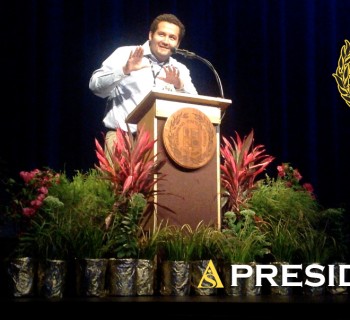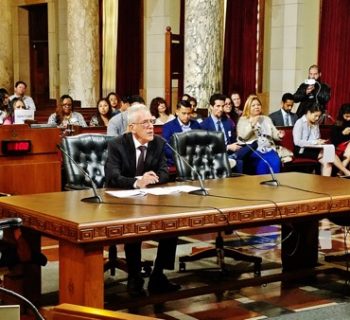To 'Latinx' or not to 'Latinx' - A modest proposal.
Opinion by Dr. Gonzalo Santos | FEB. 12, 2023
The news today is that U.S. politicians - white and Latino, who communicate mostly or exclusively in English and represent both sides of the political spectrum -, are actively trying to "ban" the term "Latinx" from official use in places like Florida, Connecticut, and Arkansas.
Aside of such a ridiculous (and quite predictable) display of “performative politics,” it bears reviewing the origins and significance of this term in the context of today’s highly contested cultural landscapes. It is a fascinating example of how identity-construction originates, evolves, and intersects with ethnicity, nationality, gender, and language - and even cultural imperialism, as we shall see.
The term "Latinx" first appeared in the American English vernacular around 2004 as a neologism used to denote people of Latin American national origin, cultural heritage, or ethnic identity living in the United States. Its plural is "Latinxs." Words used for similar purposes include “Latino/a,” "Latin@" and "Latine." (People living in Latin America have continued to be generically referred to in U.S. English as Latin Americans.)
The gender-neutral ⟨-x⟩ suffix was specifically launched by non-binary or gender fluid English-speaking U.S. Latinos and Latinas to replace the gendered-ending <-o> and <-a> of their pan ethnic labels, which are typical of grammatical gender in Spanish and which, in the euphoria and aftermath of the U.S. ethnic movements of the Civil Rights Era, were incorporated into the U.S. English lexicon in the 1980s. The suffixes <-o/a> and <-@> were introduced earlier, meant to make the generic “Latino” more inclusive of women.
These terms - Latino and Latina - were once linguistically innovative terms themselves, embraced as more inclusive, progressive pan ethnic labels in direct rejection of the officially endorsed, politically milder, and commercially ubiquitous term "Hispanic." Latino spoke more of Latin American republican heritage, Hispanic more of colonial subjugation by Spain.
Nobody noticed at the time or was much bothered by the gendered construction of the former and the gender-neutrality of the latter. What mattered was that both terms – Latino & Hispanic - were meant to meld (if not entirely replace) the strong national-origin ethnic identities of the various Latin American communities living in the United States to streamline and reflect the grand social construction of a so-called "multicultural society," which postulated five pan ethnicities: Native Americans, European Americans, African Americans, Latinos/Hispanics, and Asian Americans.
Precedence for this type of ethnogenesis was the social construction of “whiteness” and “blackness” of a bi-racial order in areas of colonial and later republican settlements. The aim now, in the post-Civil Rights Era, was to construct an egalitarian multicultural society, and dismantle all unjust vestiges of the previous hierarchical racial formation.

For the Mexican American communities of the U.S. Southwest just coming out of the greatest ethnic rebellion in their history - the Chicano Movement -, this process of Latino/Hispanic pan ethnic construction destabilized their forged new identity as "Chicanos.”
The terms, "Chicano" and "Chicana," were adopted in the heat of the ethnic rebellion of the 1960s and 70s to replace the ethnic terms of the previous era of “Anglo conformity”: "Mexican American," "Spanish-Speaking Peoples of the Southwest," as well as the thoroughly racialized, foreign-denoting term "Mexican." Chicano meant, above all, ethnic pride and rooted historical belonging, and a rejection of the previous U.S. assimilationist ideology. “Hispanic” – and even “Latino” – threatened to dilute all that into a new inchoate ideology of multicultural assimilationism.
Many veteranos from that era rejected both pan ethnic labels and identities - as mockingly captured by the poet Alurista early on: "I'm not his-panic, her-panic, or anybody's-panic!"; and later, “Latinos speak Latin, I don’t speak no Latin, ese!” Others, continue to assert their Mexican roots: “I’m Mexican, not Mexican’t!” Or as Cheech Marin considers the defiant essence of Chicanismo in a changing society: “Soy Chicano, ¿y qué?”
But now we confront two added complications to Chicano ethnic identity. On the one hand, we have the younger Chicano activists embracing the gender-neutral neologisms "Chicanx" and "Xicanx"! (Interestingly, the other Latin American diasporic communities in the U.S. are much more prone to embrace Latino identity, reject Chicano identity as restricted to Mexican-origin communities, and have experienced few linguistic challenges to their national-origin identities, for the simple fact that they are expressed in English: Cuban American or Cuban, Salvadorean, Guatemalan, Central American, Dominican, Venezuelan, etc.).
On the other hand, the ethnocultural landscape in the United States has been profoundly transformed – transnationalized – by the recent massive waves of immigrants from Latin America. This has meant that new diasporic Latin American communities in the U.S. have had little trouble embracing and reconstructing “Latino” identities, but as transnational identities in direct opposition to “American.” That is, Latino in the U.S. has become an identity connecting diasporic peoples within themselves, with each other, and with their nations of origin – destabilizing the domestic construct of the “multicultural society” and its 5 pan ethnicities.
The internal linguistic battles among Latinos in the U.S. over how to label their pan ethnicity have spilled into two external domains:
First, it has now involved all U.S. social, political, educational, & cultural institutions, leading to the present attempts within them to ban or adopt the term "Latinx" – and not necessarily waiting for a Latino national referendum for guidance. In fact, as the latest survey from the Pew Research Center shows, no more than one to seven percent of the Latino population uses the term, depending on location, age, immigrant status, main language, level of education, and political affiliation. Sixty-five percent of those Latinos who have even heard the term think it should not be used and the vast majority prefer Hispanic or Latino.
The danger here is that U.S. institutions and political forces will now impose the Latinx term, or ban it, or use it as a wedge issue politically, or manipulate it commercially, depriving Latinos of agency in the forging of their evolving identities.
The other disruptive, ominous trend is the export of the internal debate among English speaking U.S. Latinos and U.S. institutions, to adjacent Spanish-speaking countries of the region of North America, Central America, and the Caribbean. The <-x> and <-e> suffixes are now being inserted to replace all sorts of gendered terms with <-a> and <-o> endings. The grammatical disruption of this in the gendered language of Spanish is infinitely greater than in gender-neutral English. And the <-x> itself is simply unpronounceable in Spanish, which is why the <-e> suffix is more popular.
A word on the gendered nature of Spanish grammar. As the second most-spoken language by native speakers in the world, Spanish has been constantly enlarged by words originating in other languages. This continues to happen in two stages: after grammatically adapted use by millions of ordinary speakers, which leads eventually to becoming officially incorporated in the dictionaries approved by the national language academies. Neither of these things have happened to the <-x> or <-e> suffixes, and precisely because of their extensive grammatical disruptions, probably never will.
As to the gender attached to words, they are purely the arbitrary result of traditional practice, not logic. Even the grammatical rule of assigning gender to words that end in <-a> or <-o>, there are many arbitrary exceptions. Some words that end with those vowels – like pianista – are gender-neutral. And some female words in Spanish are male in French, and vice-versa. Gendered languages like Spanish or French evolve at their own pace, and imposing unto them an imported grammatical rule from U.S. English-speakers squabbling among themselves on how to enforce their language's gender neutrality is a form of cultural imperialism.
It remains to be seen how long the <-x> suffix fad will continue in the strongholds of the U.S. academy, press, and social movements. Clearly its adoption or rejection has already become another opportunist “culture war” issue in the U.S. political arena today - both on the left and the right! In fact, the right-wing culture warriors are now feigning shock and outrage, fanning the debate over its use to pry more conservative, homophobic, "Hispanic" voters away from those "woke" Latino Dems. (It's no surprise that the scaredy Dems are responding by trying to ban the term themselves!).
And way back in line in the culture wars are the veteranos of the Chicano movement, which comedian and Chicano art collector Cheech Marin mocks as Chicanosaurses. Having lost the battle over the broad adoption of the Latino pan ethnic and immigrant transnational identities, they are now taking their last stand over the adoption of the terms “Xicano” and “Xicanx” among the militant youth organizations. They scored a major victory with the recent inauguration of The Cheech Marin Center for Chicano Art & Culture of the Riverside Art Museum. But they already lost the battle over the name of the most famous network of Chicano student organizations – M.E.Ch.A. (Movimiento Estudiantil Chicano de Aztlán). Stay tuned what labels emerge to denote militant Latino student movements.
A final warning on language suppression and a modest proposal on how to bridge the present conundrum of the gendered suffixes. It has long been observed that nothing inflames ethnonationalist movements more than to have their languages suppressed. Polish nationalism, Puerto Rican nationalism, and South African nationalism, arose in part as a response to the banning of their native languages in their educational systems and the imposition of Russian, English, and Afrikaner, respectively, as languages of instruction.
Solutions to emerging linguistic conundrums usually work themselves out by the long term adapted incorporation and usage of new terms by native speakers themselves. Official labels apart, the best approach is to always allow people to self-identify and speak as they wish, including in hybrid vernaculars (pochismos), and perhaps suggest or encourage modest, efficient, easy to come, easy to adopt modifications or additions. Social and cultural movements are cradles of linguistic innovation. The best recipe is to always encourage freedom of expression, and let the generational, laminar nature of language change flow freely, as a key aspect of the social, historical construction of peoplehood. For no such construction is permanent, and more crucially, they implicate us all in the ever-contested battles over the present and future of the actual political, economic, and cultural social systems we live in.
Such is the case with the new self-identifier term “Latinx.” It should not be suppressed - nor should it be imposed. Rather, it should be allowed to freely enter the venerable Pantheon of self-identifiers adopted by Latin American ethnic and diasporic communities in the United States, find its place alongside them, and fare as well as U.S. English-speakers wish it to fare.
The only suggestion I may venture in the spirit of unity and linguistic conflict resolution to my English-speaking brothers and sisters and non-binary friends, is to simply return to an English term to identify the U.S. Latin American-origin pan ethnicity and diasporic communities: return to the already existing gender-neutral term "Latin," and let it coexist with the present, popular, Spanish-imported "Latino" and "Latina" as generic identity terms. And yes, those who prefer to identify as "Latinx," Latin@," and "Latine" do so to denote their gender neutrality or fluidity. As to official uses, remember how "Ms." became the preferred honorific term for women, retaining gender but avoiding reference to marital status, while allowing the continued use of "Mrs." and "Miss." when desired. Same here: use “Latins” and “Latin” and see if it sticks.
This simple, modest proposal should satisfy the English-speaking gender-orientation activists of Latin American heritage in the United States today and help prevent the further disruptive export of the <-x> suffix into the Spanish-speaking world - both domestically and internationally. This vast and vibrant culture zone, to which I and half a billion others belong in the Americas, including the many Spanish-speaking diasporas in the U.S., is also slowly dealing with its gendered grammar, to make it more inclusive of women, Indigenous, gender-fluid, African-descent, and other social groups. Linguistic innovation is inevitable, but it need not be as a result of U.S. cultural imperialism.
Ironically, do not be surprised that in a few years or decades, all these socially constructed and reconstructed labels and identities in both the English- & Spanish-speaking worlds will probably be replaced by entirely new ones - even our respective national identities.
The regional identifier "North American" / "Norteamericano" / "Nord Américain" is lurking in the background and slowly gaining strength, accompanying all the economic, migratory, and geopolitical projects of regional integration unfolding today. Same with “Sudamericano.”
As the social and structural integration processes erase all commercial, cultural, and political barriers and borders, we - Canadians, U.S., Mexicans, Caribbeans, and Central Americans - may all wake up on day willing to be united under a bigger and more inclusive flag - trilingual in French, English, and Spanish, fully multicultural and transnational, enjoying or demanding a much more expanded definition of citizenship for the entire region, embracing a (northern hemispheric) version of "Nuestra America" that not even José Martí envisioned in his time: ¡Norteamericanos somos todos! (This may happen even sooner in South America, where they do not have to deal with required U.S. participation.)
As to, ¿Are we all Americanos? Well, yes, perhaps after a period of accelerated North American and South American economic, sociocultural and political integration, it would seem to be the next logical step in the historic construction of peoplehood in the Americas. But for now, just embracing, constructing, and completing two huge continental integrations projects is quite a daunting challenge.
One major historic step at a time, people.
Así que vámonos con calma, y no nos hagamos bolas. Que cada quién EN SU IDIOMA Y SU PAÍS, EN SU REGIÓN Y SUS DIÁSPORAS, hablen y se identifiquen como mejor quieran - sin acatar o seguir ciegamente modas ni reglas absurdas importadas - mejorando su lenguaje y su cultura como mejor le convenga y prefiera mientras navegamos todos en el turbulento mar del presente hacia un destino incierto.
¿Así o más claro/clara/clare/clar@/clarx?







